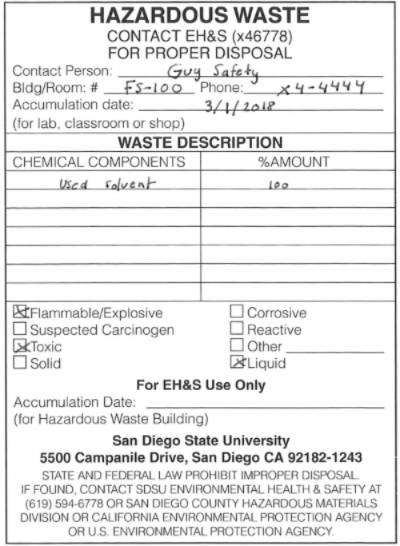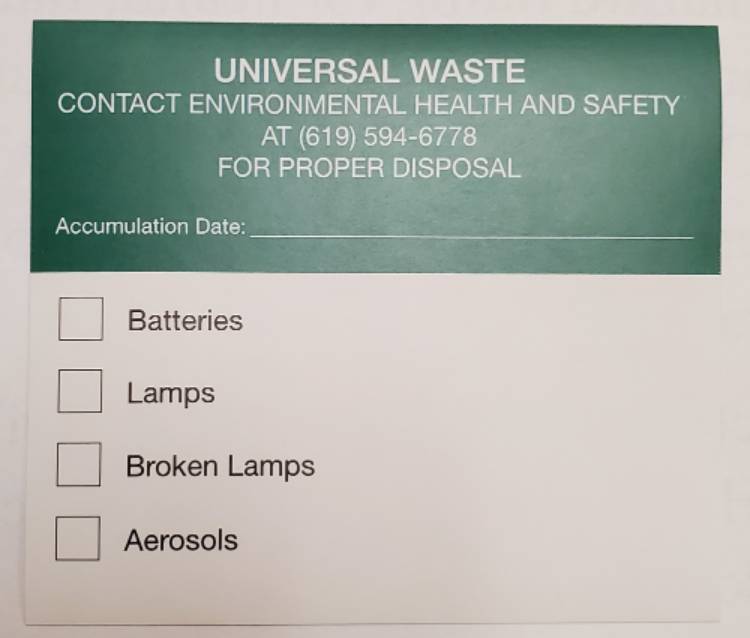Hazardous Waste
Request a hazardous waste pickup by using the Hazardous Waste feature in BioRAFT:
The Hazardous Waste Pickup Request Instructions can help guide you through the process. You may also request labels and empty containers using the request system. Allow for seven business days from requesting waste removal to actual pickup/drop off.
Hazardous Waste Guides
Hazardous Waste Posters
Chemical Hazardous Waste Labels can be obtained through EHS by submitting a Hazardous Waste request in BioRAFT.
Hazardous waste containers must have a completed chemical hazardous waste label attached at the time chemical hazardous waste is first added to the container.
The chemical hazardous waste label must be completed with:
- Contact person: the person EHS can contact with questions about the hazardous waste
- Phone number: Contact person’s phone number
- Building and room#: Where the chemical hazardous waste container is used to collect chemical hazardous waste
- Accumulation Start Date: the date the first drop of liquid or the first article of solid chemical hazardous waste went into the container
- Chemical Components: The identity or identities of the ingredient(s) of the chemical hazardous waste container
- Hazard Boxes: check the SDS’s for the hazards of the waste and check the appropriate boxes.
- Physical State: Solid or Liquid

SAA’s are the laboratories, shops and studios where the chemical hazardous waste first starts being accumulated, also called points of generation. The point of generation needs to be under the control of the person(s) producing the waste which means it can not be moved from one place to another and needs to stay in one room.
Time Limits: Chemical hazardous waste accumulation containers can be used for up to 9 months after the start of the accumulation date written on chemical hazardous waste labels. Chemical hazardous waste must be given to EHS after no longer than 9 months (or 3 days after the quantity limit has been reached).
Quantity Limits: SAA’s cannot contain more than 55 gallons of chemical hazardous waste liquids or 500 pounds of chemical hazardous wastes solids, or 1 L or 1 kg of acutely hazardous chemical hazardous waste.
Storage Requirements:
- The chemical hazardous waste must be compatible with the container that it is being stored in.
- Incompatible chemical hazardous waste must be stored separate from each other by a
physical barrier or distance so that if broken the contents of the containers cannot
commingle. Examples of incompatible chemical hazardous wastes:
- Flammables and Oxidizers
- Acids and Bases
- OrganoMetals and Aqueous Wastes
Submit a biohazardous waste removal request by submitting a waste request in BioRAFT. Biohazardous waste typically includes red bags and medical waste sharps containers.
Pre-printed biohazard bags:
Large biohazard bags (37” x 48”) pre-printed with SDSU’s address are available from EHS for on campus labs. There is only one size available at this time. Please submit your request using the waste request in BioRAFT.
Address Labels:
- Address labels must be placed on medical waste sharps containers.
- If you are not using red bags that are prelabeled then they must be labeled with a generator address label prior to use. It is best to apply the generator address label to the middle or bottom of the red bag so that it is still legible after the red bag is tied. Red bags must be tied as soon as they are 75% full or no more biohazardous waste will be put into the red bags.

Secondary Containers:
- Red bags must be inside a secondary container while in use, transport, and storage.
- Secondary containers must be sterilized before being used again.
Submit a universal waste removal or a universal waste label request by submitting a Hazardous Waste request in BioRAFT.
Common universal wastes include but are not limited to batteries, lamps, aerosol cans (full or empty), mercury containing items like thermometers and thermostats, and electronic waste. Universal waste has low level hazard properties and cannot be put into the municipal trash.
Storage Requirements: While in transport and storage, universal waste must be in containers compatible with the waste; for example, cardboard boxes are sufficient to contain used lamps. The container must be closed when in storage and opened only when materials are being put into them.
Labeling: A universal waste container must be labeled properly with “Universal Waste”, the identity of what is inside the container, and the date the first item of universal waste went into that container. The label must be attached before the first waste item goes into a container.

Accumulation Time: Universal waste needs to be removed by EHS when the container is full or has reached its nine month accumulation time. Accumulation time is based on the date written on the container’s universal waste label.